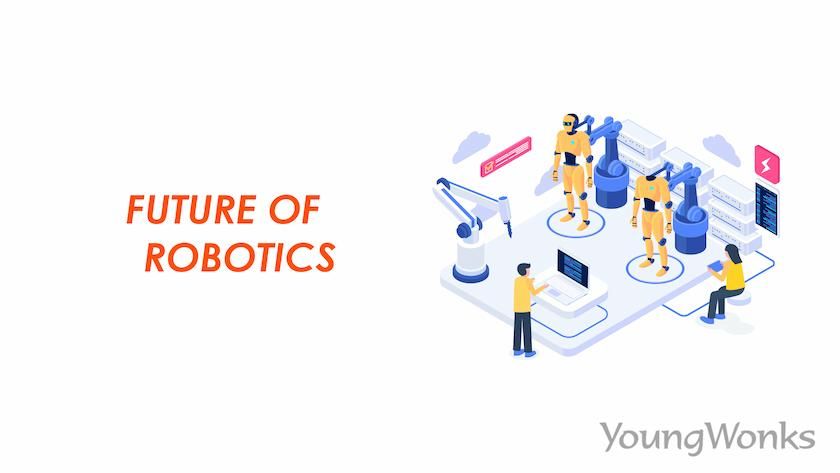Nov 30, 2024 By Team YoungWonks *
Types of Robots
Robots come in various forms, each designed to serve different purposes. The main types of robots include:
- Industrial Robots: Used in manufacturing, these robots perform repetitive tasks such as welding, assembling, and packaging with high precision.
- Service Robots: These include household cleaning robots, security robots, and customer service bots used in retail and hospitality.
- Medical Robots: Used for surgeries, rehabilitation, and patient assistance, medical robots improve healthcare delivery.
- Autonomous Vehicles: Self-driving cars, drones, and delivery robots are revolutionizing transportation and logistics.
- Humanoid Robots: These robots are designed to mimic human appearance and behavior, often used for social interactions and customer service.
- Exploration Robots: Used in space and deep-sea exploration, these robots can operate in extreme environments where human presence is not feasible.
Artificial Intelligence and Automation in Robotics
The integration of artificial intelligence (AI) and automation lies at the heart of the future of robotics, driving innovation and transformation across various industries and domains. Let's delve deeper into the AI and automation in robotics:
The Role of Artificial Intelligence in Robotics:
AI is a branch of computer science and science fiction that aims to create intelligent bots capable of performing tasks that typically require human intelligence. In the context of robotics, AI enables humanoid robots to perceive their environment, make decisions, and adapt to changing circumstances autonomously. AI-powered robots utilize techniques such as computer vision, natural language processing, and deep learning to interpret visual data, understand spoken commands, and learn from experience.
By integrating AI into robotics, robots can exhibit advanced capabilities such as object recognition, speech recognition, and autonomous navigation, enabling them to interact with the world in sophisticated ways.
The Impact of Automation on Efficiency and Productivity:
Automation refers to the use of new technology to perform tasks with minimal human intervention. In robotics, automation plays a central role in streamlining processes, improving efficiency, and reducing labor costs across various industries. Automated robotic systems can perform a wide range of tasks, from repetitive assembly line operations in manufacturing to complex logistical operations in supply chain management. Automation in robotics is not limited to physical tasks but also extends to cognitive tasks, where robots can analyze data, make decisions, and optimize processes autonomously leaving no shortages.
AI-Powered Robots and Their Benefits
AI-powered robots are equipped with advanced algorithms that enable them to perceive their environment, interpret data interface, and make decisions autonomously. These robots utilize techniques such as machine learning, deep learning, and neural networks to acquire knowledge, cutting-edge technology, learn from experience, and improve their performance over time. By leveraging AI, robots can adapt to changing circumstances, handle uncertainty, and navigate complex environments with precision and agility.
Main Uses of Machine Learning and How They Can Be Effective
Machine learning is a subset of AI that focuses on enabling machines to learn from data and improve their performance over time without being explicitly programmed.
In robotics, machine learning algorithms empower robots to acquire new skills, adapt to changing environments, and optimize their behavior based on feedback. Reinforcement learning, a subset of ML, enables robots to learn through trial and error, adjusting their actions to achieve desired outcomes.
These ML algorithms allow robots to recognize patterns, make predictions, and classify objects, enhancing their ability to perceive and interact with the world. The ability to learn from data, identify trends, and extract meaningful insights plays a crucial role in AI-powered robotics, enabling smarter decision-making and autonomous adaptability.
Adaptive and Autonomous Decision-Making
AI-powered robots have the capability to make autonomous decisions based on their perception of the environment and their internal knowledge representation. These robots can assess situations, analyze data, and choose the most appropriate course of action without human intervention. By combining AI with automation, robots can perform complex tasks with precision and efficiency, leading to improved productivity and safety.
The safety and reliability measures
AI-powered robots are designed to prioritize safety and reliability in their operations. These robots are equipped with sensor technology, actuators, and fail-safe mechanisms to detect and mitigate potential hazards in real-time. By leveraging AI and automation, robots can operate in hazardous environments, perform dangerous tasks, and minimize the risk to human workers.
Future Implications
The integration of AI and automation in robotics has profound implications for the future of work, society, and technology.
As robots become more intelligent and autonomous, they have the potential to reshape industries, transform business models, and create new opportunities for innovation and growth.
Collaboration between humans and robots will become increasingly common, with robots augmenting human capabilities and enhancing productivity in diverse settings.
The Role of Robotics in Healthcare Revolution
The application of robotics technology in healthcare industry represents a transformative shift in patient care and healthcare delivery, offering innovative solutions to improve efficiency, accuracy, and patient outcomes. Let's explore the various facets of the healthcare revolution enabled by robotics:
Surgical Robotics:
Surgical robots, such as the da Vinci Surgical System, assist surgeons in performing minimally invasive procedures with unparalleled precision and dexterity. These robots offer enhanced visualization, improved ergonomics, and greater maneuverability compared to traditional surgical techniques, resulting in reduced trauma, faster recovery times, and improved surgical outcomes for patients. Surgical robots enable surgeons to perform complex procedures with greater accuracy, leading to fewer complications and better patient outcomes.
Robot-Assisted Therapy:
Robotics technology is being increasingly utilized in rehabilitation and physical therapy to assist patients in regaining mobility and motor function. Rehabilitation robots, such as exoskeletons and robotic prosthetics, provide personalized therapy programs tailored to individual patient needs, facilitating recovery and improving quality of life for patients with mobility impairments.
Telemedicine and Remote Monitoring:
Robotics technology enables the development of telemedicine platforms and remote monitoring systems that connect patients with healthcare providers virtually. Telepresence robots equipped with cameras and sensors allow healthcare professionals to remotely interact with patients, conduct consultations, and monitor vital signs in real-time, bridging geographical barriers and expanding access to care, especially in rural or underserved areas.
Medical Logistics and Supply Chain Management:
Autonomous vehicles and drones equipped with robotics technology are revolutionizing medical logistics and supply chain management. Delivery robots transport medical supplies, medications, and specimens within hospitals and healthcare facilities, reducing the risk of human error, improving efficiency, and ensuring timely delivery of critical resources.
Diagnostic and Imaging Robotics:
Robotics technology enhances diagnostic accuracy and precision in medical imaging and diagnostic procedures. Robots equipped with computer vision and deep learning algorithms assist radiologists in interpreting medical images, detecting abnormalities, and generating diagnostic reports with greater speed and accuracy, leading to earlier detection and more effective treatment of diseases with the help of generative ai.
Patient Care and Assistance:
Social robots and robotic companions provide emotional support, companionship, and assistance to patients in healthcare settings, particularly in long-term care facilities and rehabilitation centers like social media. These robots engage patients in therapeutic activities, remind them to take medications, and provide companionship, alleviating feelings of loneliness and isolation among patients, especially the elderly or those with chronic illnesses.
Industrial Innovation
Industrial robots equipped with advanced sensors and actuators are revolutionizing manufacturing processes by automating repetitive tasks, enhancing precision, and optimizing efficiency.
These robots are capable of performing a wide range of tasks, including welding, painting, assembly, and material handling, with speed and accuracy, leading to increased productivity and cost savings.
Collaborative robots, or "cobots," work alongside human workers in manufacturing environments, enhancing safety and efficiency by taking on repetitive or dangerous tasks, while human workers focus on more complex and skilled activities.
The integration of robotics technology in industrial settings improves workplace safety, reduces ergonomic challenges, and enhances overall productivity, driving innovation and competitiveness in the manufacturing sector.
Enhancing Everyday Lives
Robotics technology is increasingly being integrated into various aspects of daily lives, offering solutions to tasks and challenges encountered in home, work, and leisure environments.
Self-driving cars equipped with robotic systems and AI algorithms navigate city streets autonomously, offering convenience, safety, and efficiency in transportation.
Robotic assistants, such as robotic vacuum cleaners, lawn mowers, and personal assistants, perform household chores and tasks, freeing up time for individuals to focus on more meaningful activities.
Social robots and companions provide emotional support, companionship, and assistance to individuals in healthcare facilities, homes, and public spaces, enhancing well-being and quality of life.
Exploring New Frontiers
Robotics technology plays a crucial role in space exploration, enabling the exploration of distant planets, moons, and celestial bodies that are inaccessible or hazardous to humans.
Robotic systems equipped with advanced sensors, AI algorithms, and autonomous capabilities conduct scientific research, gather data, and perform tasks in extreme environments, such as space, deep-sea, and polar regions.
Exploration robots, such as rovers and landers, gather scientific data, analyze samples, and search for signs of life, expanding our understanding of the universe and paving the way for future human exploration and colonization efforts.
Challenges and Considerations in Robotics Technology
While robotics technology offers immense promise and potential, it also presents various challenges and ethical considerations that must be addressed. Ensuring responsible deployment and usage is crucial to maximizing benefits while mitigating risks.
- Job Displacement: Automation may replace certain jobs, necessitating workforce reskilling and upskilling to adapt to changing industry demands.
- Ethical Concerns: AI-driven decisions must align with ethical guidelines to prevent biases, discrimination, and unintended consequences.
- Human Interaction and Social Impact: The increasing use of robotics in various sectors may reduce human intervention, potentially altering social dynamics and interpersonal relationships.
- Data Privacy and Security: Protecting sensitive data in an AI-driven world is critical to preventing breaches, unauthorized access, and cyber threats.
- Safety and Security: Ensuring that robotic systems operate safely and securely is essential to avoid potential risks and unintended consequences in real-world applications.
- Collaboration and Regulation: Effective collaboration among researchers, policymakers, and industry leaders is necessary to develop regulations, ethical standards, and frameworks for responsible robotics deployment.
By proactively addressing these challenges, we can harness the full potential of robotics technology while ensuring its ethical, safe, and beneficial integration into society.
Conclusion
The future of robotics holds boundless opportunities for innovation, breakthroughs, and societal advancement. From enhancing healthcare delivery and transforming industries to exploring new frontiers and enhancing everyday living, robotics technology is poised to redefine the way we interact with the world. By embracing technological advancements, fostering collaboration, and addressing ethical considerations, we can harness the transformative power of robotics for the betterment of humanity and the advancement of society. For further discussions on the latest trends in robotics and tech, follow experts on LinkedIn and connect with leading startups innovating in this space.
*Contributors: Written and Edited by Disha N; Lead image by Shivendra Singh

